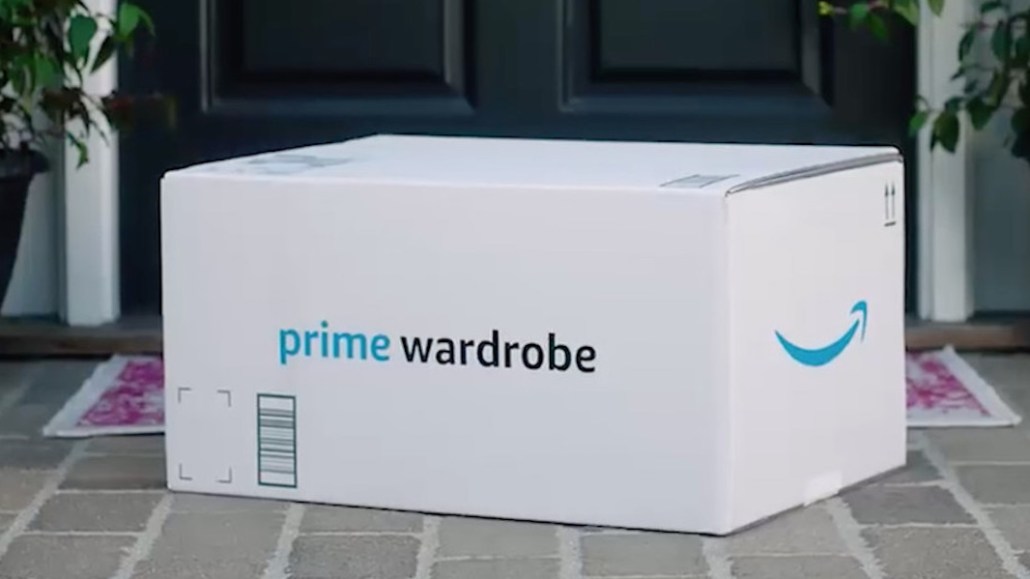

When Amazon announced the launch of Prime Wardrobe, a try-before-you-buy service for Prime customers, the immediate implication was that the retailer had eliminated the friction around returns and customer service in its clothing department.
The program, which has yet to launch, lets customers shop from eligible brands — to be included, brands must be Amazon wholesale partners — and choose between three and 15 items to try on at home, for free. They’ll only be charged for anything that’s not sent back within a week, and items come in a resealable, prepaid shipping box. Amazon
The premise is one borrowed from style startups like Stitch Fix and Trunk Club that deliver a box of suggested items to members, who then pick what to keep. For Amazon, which hasn’t announced the brands that will be eligible for Prime Wardrobe yet, it encourages apparel purchases by eliminating customers second-guessing about fit and style.
But in a category like lingerie, Prime Wardrobe might be too intimate.
“With bras, you don’t want to encourage people wearing it around for a week and sending it back,” said Marissa Vosper, the co-founder of online lingerie brand Negative Underwear.
For Negative Underwear, Amazon’s appeal as a retail partner is obvious as it looks to scale. Its reach is unparalleled, and within apparel, lingerie is the fasting-growing category, she said. (Overall, the global lingerie market is worth $28 billion as of 2016.) Bras and underwear even play into one of Amazon’s biggest strengths: replenishment. Vosper said that once customers become loyal to a specific brand, lingerie becomes a relatively utilitarian purchase.
But on the downside, fit is the biggest factor in purchasing a bra, and to get customers to trust a new brand that lives only online, easy returns and conscientious customer service is crucial. Vosper said that women are more willing to make a first-time lingerie purchase online if the brand offers easy returns and high-touch customer service.
Outside of Prime Wardrobe, Amazon’s typical returns are free for Prime members, but require gathering shipping materials and waiting for a refund, a process that universally frustrates online shoppers and can eat away at a retailer’s profits. From a customer service perspective, wrangling a response from a real-life Amazon associate when dealing with the process has proven difficult, as its customer service system, by phone or chat, is automated.
“A retailer has to really understand customer service to [provide what] feels like a good shopping experience,” said Malinda Sanna, founder of the agency Spark. “So far, Amazon has nailed shipping and distribution. Then, they kind of fall off.”
In the lingerie space, Amazon’s selection is currently heavily price-driven. Brands like Playtex sell bras for as little as $7. In Amazon’s push to build out its private apparel brands, it launched its own line of bras that retail for $10 each. For a new direct-to-consumer brand, a popular business model for digital-born lingerie brands, it’s not a good deal.
“In terms of evaluating partnerships in retail, we want to know: Is there money to be made?” said Vosper. “As a direct-to-consumer brand, we don’t have the markups padding a wholesale partnership that other brands build into their pricing. But once people are sold on our brand, Amazon as a replenishment retailer is huge.”
Where Amazon has improved its customer service with Prime Wardrobe and free returns, it’s relegated it to Prime member benefits. Typically, those are only available to the company’s wholesale brand partners. But it’s harder for emerging brands, even in the fashion space, to become a wholesale partner. Amazon moves massive volume, so for small brands, it’s a tall order to fill. It also wants to see a newcomer prove itself on the independent seller platform first, before accepting it as a wholesale partner.
“Amazon isn’t going to create the demand around a product. Brands still have to create that demand,” said Jim Fosina, the CEO of the branding agency Fosina Marketing Group. “But if you’re looking to build brand longevity, it may not be the best partner.”
A brand like Negative Underwear — and similar competitors, like Adore Me, Lively and ThirdLove — may not want to be sold next to a $7 Playtex bra this early in the game. But it’s still not so simple to shirk Amazon entirely.
“It’s the great debate. Anyone you speak to in fashion, when you talk about Amazon, says, ‘Why would you sell to them? They don’t know fashion.’ Anyone in the tech world says, ‘Why would you sell to Bloomingdales? They don’t know how to do e-commerce. Wholesale is being rethought every day. Maybe there’s a reason for a transactional partner like Amazon in the future.”
More in Marketing

Marketers are keen to use generative AI in ad campaigns, but hidden costs lurk
Marketers across the industry want to use AI to cut down on time spent in creative production. It’s not so simple in practice.

2025 was rough for Target. It could also be the year when its turnaround began
Much of the front half of the year for Target was defined by the company’s decision in January to pull back on DEI initiatives.

How brands shifted marketing and media strategies through year of tariffs
Marketers share how they navigated the maze of tariffs and regulatory changes this year.








